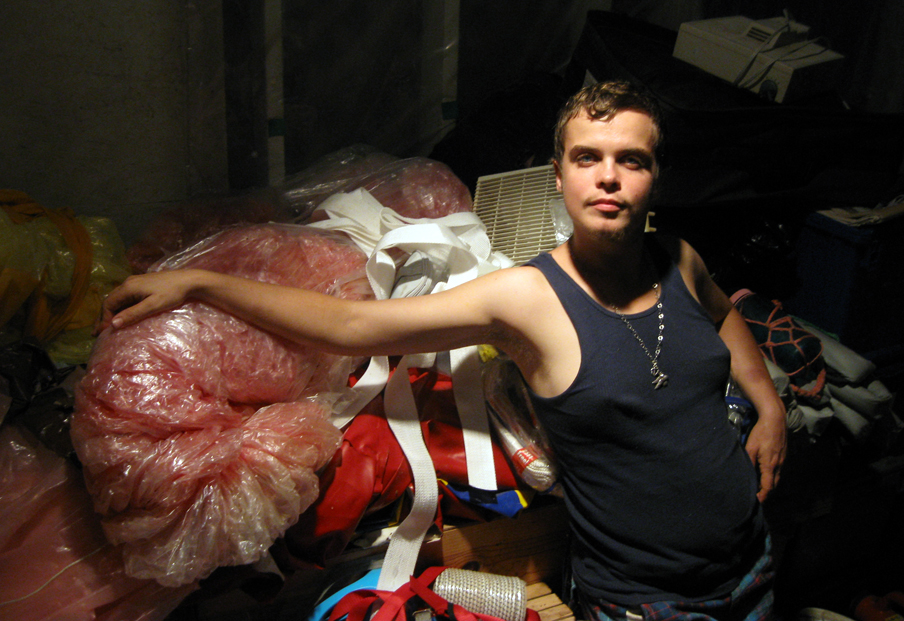
Flo McGarrell at his studio in Vermont.
Flo McGarrell is a visual artist based in Newbury, Vermont, USA and Jacmel, Haiti. He was born in Rome, Italy to American expatriate artists. McGarrell received a B.F.A. in Fibers and an M.A. in Digital Arts at the Maryland Institute College of Art in 1998. He then attained an M.F.A. in Art and Technology Studies at The School of the Art Institute of Chicago where he implemented his hybrid skills in sculpture and digital craft to create architectural scale inflatable sculptural interiors animated with air pressure, light, sound, and video projections. He is currently serving as the director of FOSAJ, a non-profit art center in Jacmel, Haiti.
McGarrell is a full-time resident of Jacmel and during the summer months he retreats to his studio in Vermont. In Haiti, McGarrell’s studio is located on the second floor of FOSAJ, which was previously a coffee warehouse. The FOSAJ space also serves as his living quarters, a place for his assistant, Zaka, and somewhere to hang his hammock.
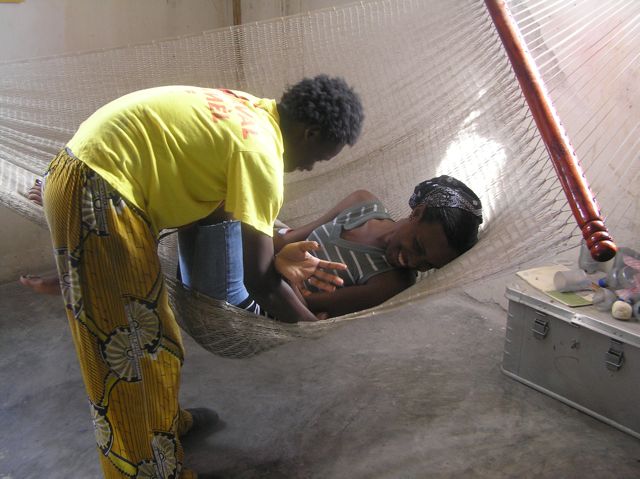
Zaka tickling Stacy, FOSAJ office/studio/living quarters.
McGarrell tells me that Jacmel is a place where the senses awake–it is visually rich and energetic. The view outside the window is the bright Haitian sunlight, the ocean, coconut palms, almond and mango trees. The breeze brings him smells such as burning trash, cigarette smoke, marijuana from the beach and, in the evenings, the bar next door blasts Kompa music.
It wasn’t so long ago that McGarrell excelled in the making of inflatable sculptures, now specializes in “agrisculptures.” I will say no more. I encourage you to visit his latest show called I ♥ Agrisculpture at AVA Art Center and Gallery in Lebanon, New Hampshire.
The artist adds, “All of the pieces fall under the definition ‘Agrisculpture’ and are part of home-scale food production systems. All works are made with secondhand, found, intrinsically colored plastic, organic material and plants. All pieces are the result of experimentation undertaken in Roswell, New Mexico, Newbury, Vermont, and Jacmel, Haiti.”
My interview with the artist is below and it is an absolute pleasure introducing you to this gutsy artist and friend.
Georgia Kotretsos: Flo, you have a base in Newbury, Vermont, and another in Jacmel, Haiti. Does each space accommodate different studio needs or do you feel like an artist at work in one place more than the other?
Flo McGarrell: I seem to be an artist-person who has only a little separation between art and life–if you will please excuse the cliché. Specifically, I attack whatever I am working on with an obsessive compulsion that we creative types are often afflicted with. It doesn’t stop no matter where I am, regardless of whatever else I am doing. The objects of my ministrations include sculpture, art direction for film, performative identity adjustments, installation, kleptomaniac collecting schemes, so I must be poised to work wherever I am at all times. Whether it’s from my own body, or my car, a suitcase, a friend’s house or anywhere else I find myself.
That being said, the place I feel most enabled to create my sculptural work is my Vermont studio. It has lots of stuff, junk and tools I have collected over the years, and is always ready and waiting for me to use, exactly as I left it.
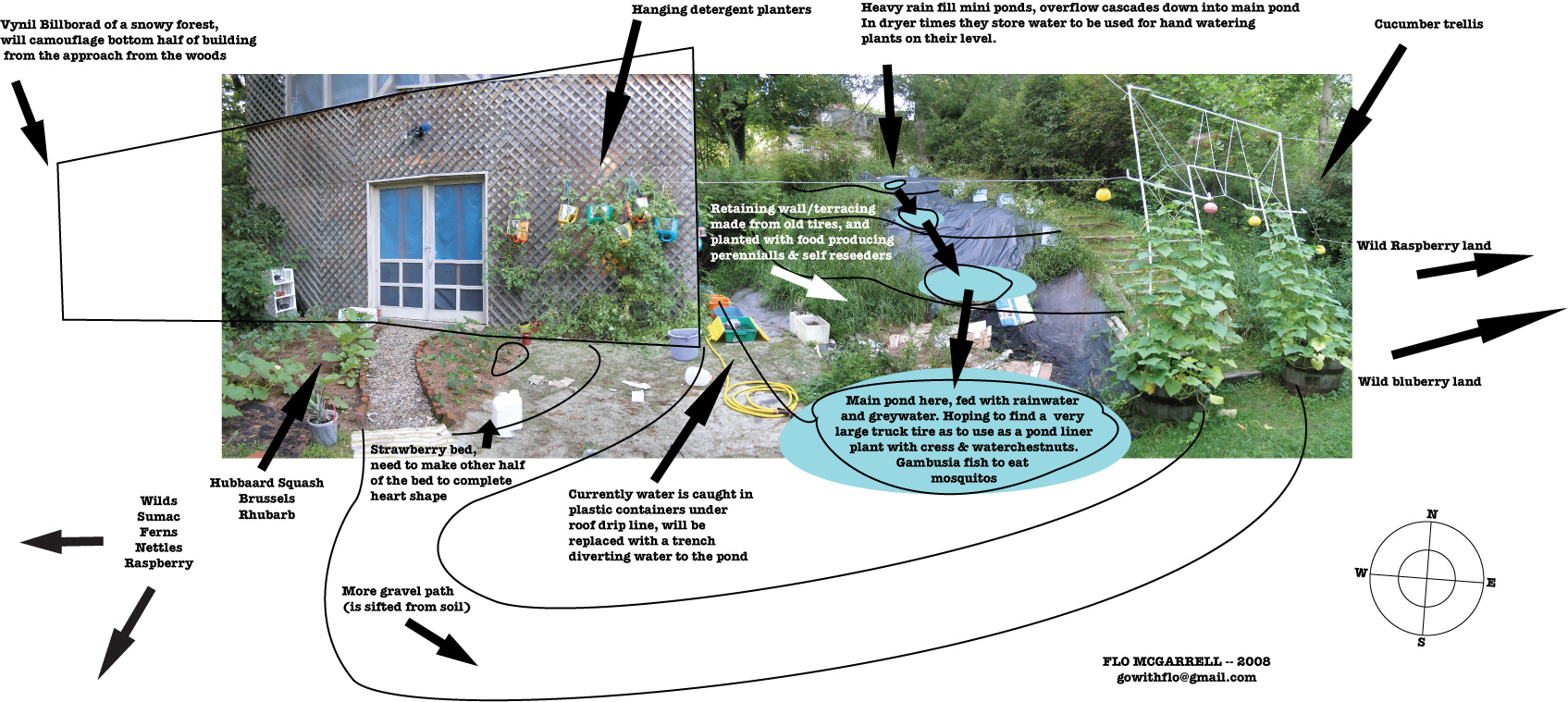
Proposing changes to the landscape around the Vermont studio.
It’s lonely and quiet and boring which is good because I can be easily distracted–a stark contrast to all the fun and hectic confusion of the Haitian base of operation at the FOSAJ art center. My space there is barraged with people coming in and out bursting forth ideas and conflict. So, the office facilitates group artistic endeavors, collaborative problem solving — it’s starting to seem more and more like a social experiment. But we have less material, art supplies are scarce and are used up quickly, tools always disappear, so it’s a very needy, hungry place. We make art hand to mouth. I feel a little bit more like a therapist-administrator there, but making the center work is definitely a creative pursuit in the same family as all the other projects I choose to adopt as an artist-person.
The two places are an inverse mirror of each other. My challenge is to stay sane and creative in both.
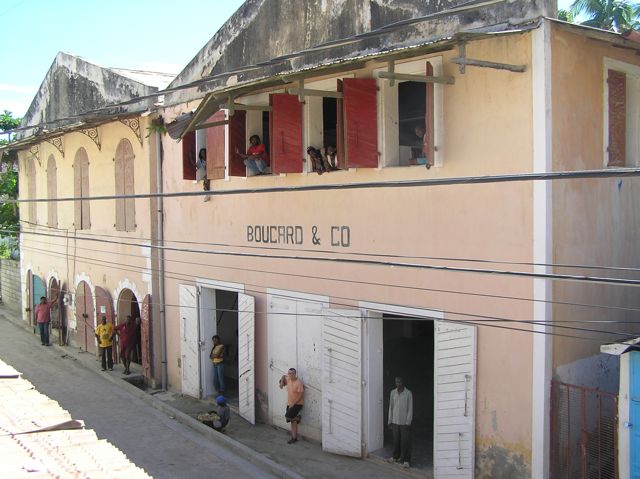
FOSAJ art center, Jacmel, Haiti.
GK: Has your stay in Jacmel affected your personal work and, if yes, in what way?
FM: My current process references living economics (poverty, anti-capitalist consumerism {dumpster diving and stealing things in and around dumpsters of grocery stores and construction sites}).
The work I do in the States is conscious of the struggles of my friends living in Haiti, of how hard it is to get food, and to get one’s basic needs met. So, as an exercise I try not to buy anything in order to make the work, everything is found in the trash or stolen. It works really well for me over here in the States, but that process is nearly impossible in Haiti, where it is very rare to find something useful in the trash (because everyone is already ingeniously reusing things), and it goes without saying that I wouldn’t steal anything in Haiti.
So, my personal work (Agrisculpture) is much more slow going there. I not only have to find my second hand materials, suited to my precise specification (intrinsically colored plastic, bulk organic material) but also bargain the merchant down from the outrageous blan (foreigner) price they always give me, by that time we reach a still inflated but more reasonable price I can be frustrated, and the flow of finding materials I am “meant” to use has been slightly dampened. It works better as a communal effort. I am leading a permaculture workshop there, and we are slowly, but surely, working on a rain barrel shower sculpture for the center, a bicycle-powered washing machine, and a parabolic solar oven.
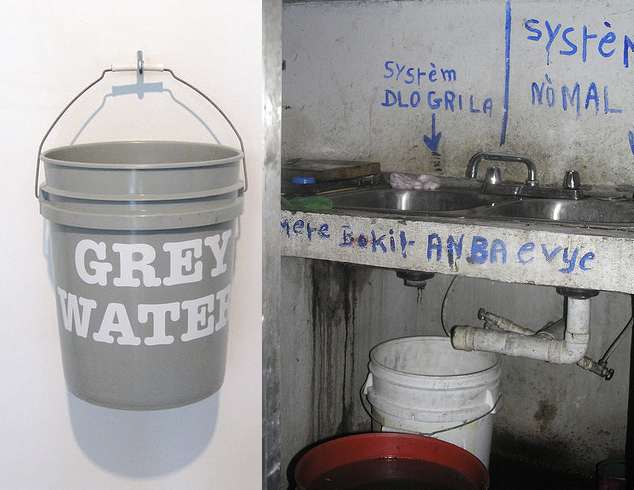
We are already grey watering, gardening and composting.
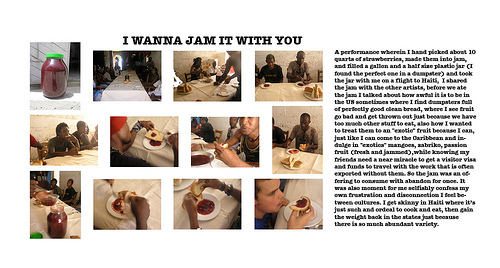 One recent piece that attempts to bridge this divide between my cultures was a performance wherein I hand picked about 10 quarts of strawberries, made jam, filled a gallon and a half size plastic jar (I found the perfect one in a dumpster), took the jar with me on a flight to Haiti, and shared the jam with the other artists in the center. Before we ate the jam I talked about how awful it is to be in the US sometimes where I find dumpsters full of perfectly good clean bread, where I see fruit go bad and get thrown out just because we have too much other stuff to eat. Also, how I wanted to treat them to an “exotic” fruit because I can, just as I can come to the Caribbean and indulge in “exotic” mangoes, zabriko, passion fruit but I did this knowing my [artist] friends in Haiti need a near miracle to get a visitor visa and funds to travel with the work that is often exported without them. So the jam was an offering to consume with abandon for once. It was the moment where I selfishly confessed the frustration and disconnection I feel between the two cultures.
One recent piece that attempts to bridge this divide between my cultures was a performance wherein I hand picked about 10 quarts of strawberries, made jam, filled a gallon and a half size plastic jar (I found the perfect one in a dumpster), took the jar with me on a flight to Haiti, and shared the jam with the other artists in the center. Before we ate the jam I talked about how awful it is to be in the US sometimes where I find dumpsters full of perfectly good clean bread, where I see fruit go bad and get thrown out just because we have too much other stuff to eat. Also, how I wanted to treat them to an “exotic” fruit because I can, just as I can come to the Caribbean and indulge in “exotic” mangoes, zabriko, passion fruit but I did this knowing my [artist] friends in Haiti need a near miracle to get a visitor visa and funds to travel with the work that is often exported without them. So the jam was an offering to consume with abandon for once. It was the moment where I selfishly confessed the frustration and disconnection I feel between the two cultures.

Flo McGarrell, I Wanna Jam It With You, FOSAJ artists, 2008.
GK: Between 2006 and 2008 three major green or better environmental art shows took place in the States: Beyond Green: Toward a Sustainable Art, curated by Stephanie Smith, Smart Museum of Art, University of Chicago, 2006 (ongoing); Weather Report: Art and Climate Change, curated by Lucy R. Lippard, Boulder Museum of Contemporary Art, 2007; and Design and the Elastic Mind, curated by Paola Antonelli and Patricia Juncosa Vecchierini, MoMA, 2008. How fast is the genre growing and how do you define yourself as a sculptor?
FM: While I did not get a chance to see any of those shows, I have admired and felt an affinity for the works of Micheal Rakowitz, Andrea Zittel, and Temporary Services, among others. I think that artists whose work intermingles with science, technology, and design are having an especial tendency to want to deal with questions of sustainability. Perhaps because we are thinking in this systemic cause and effect mode already, and we want to see how best to apply our efforts at this time when it is clear that a lot of science, technology and design has brought us to this dangerous precipice of almost certain imminent environmental disaster. Doing these sorts of exercises and models of sustainability makes us feel better, calmer, and more secure. Maybe it’s that we offer hope, but I think more it is because what we are offering are examples of a streamlined practical thinking about the things we use and require in our built environment.
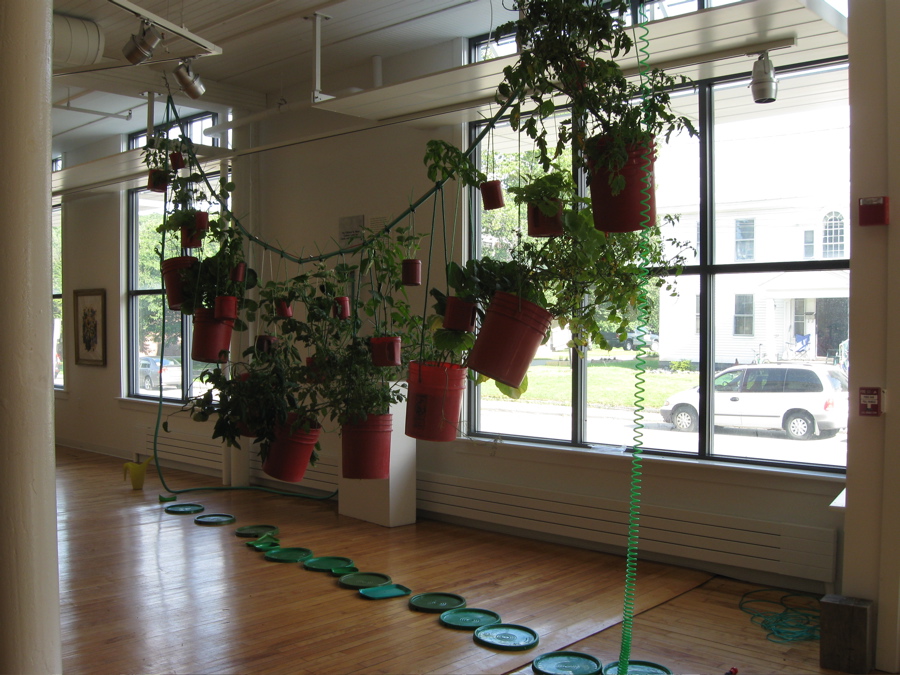
Flo McGarrell, Complete Self-Irrigating Indoor/Outdoor Hanging Food-Farm, AVA Center and Gallery,2009.
“Agrisculpture” was a term I coined to describe my work, I could have more accurately called what I do “Permasculpture”, but not as many people know what permaculture is, so since my work’s end goal is mostly about producing food I went with Agrisculpture, so that makes me an Agrisculptor.
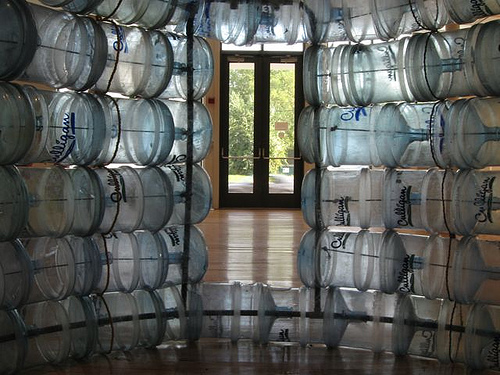
Flo McGarrell, The Megacloche, made from about 300 empty 5 gallon water cooler containers collected from a dumpster over a year in Roswell, NM. When properly finished with a roof and all crevices sealed with plastic bags this acts as a season extending greenhouse, AVA Center and Gallery,2009.
Well I hope it’s a fast growing genre with an agrisculpture department opening up in every art school by 2012 (every art student gets a little community garden plot instead of a studio?) because then I will be asked to come lecture everywhere…and I love to travel so that would be nice.
GK: What’s taken you from the inflatables to recyclable and earthy mediums?
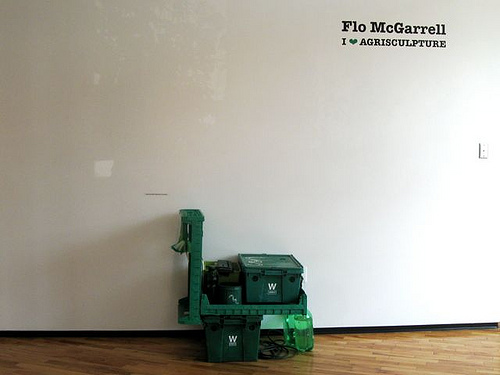
Flo McGarrell, Complete Worm Composting Appliance, everything needed to compost kitchen scraps with worms, and make worm tea to fertilize your plants, AVA Center and Gallery,2009.
FM: Well, the inflatables were also very self congratulatory but more indulgently egomaniacal. It’s funny I used to kind of have a thing against art that deals with society’s waste because I did sometimes use recycled materials in my earlier sculpture and when I was invited to participate in a festival they would sometimes enthusiastically say “use recycled materials to make art!” and I would examine those motives and conclude: A) They don’t have a budget for my artist materials; B) They want to use artists to make the festival look “green” while the festival still generates tons of trash from food vending, etc.
I felt resentful that as artists we are supposed to exhibit a conscientiousness that is not required of everyone else. So, I said “screw that, I want to have the same entitlement to use and consume just as much as everyone else, and at least I am making art.” I was really against the notion of artist as a cultural environmental remediator, especially when I felt under-supported and under-compensated for the work I was doing…so yeah, a real chip on my shoulder. So, the work I was making then required that I buy many miles of virgin plastic, nylon, and Vinyl, and I made really huge beautiful inflatable rooms.
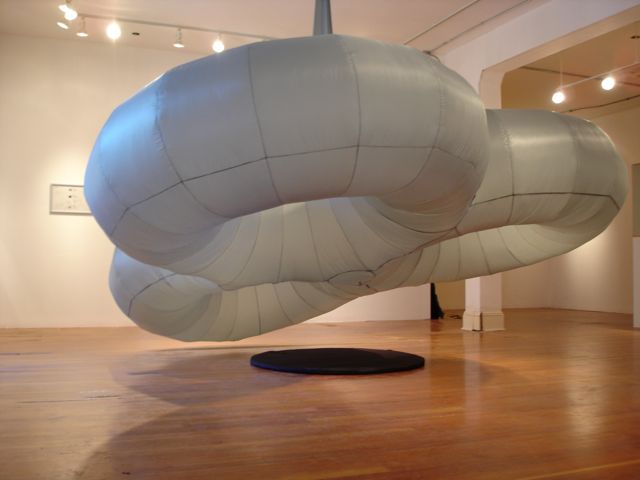
Flo McGarrell, TRI:TORII, 2004.
I felt very happy with myself, even embarrassingly god-like. Then somewhere along the way I came back to using recycled materials, not for anyone else, but for me, for my own conscience and personal ethic. There is something very satisfying for me in taking something out of the waste stream and hacking it to be useful again. I feel lucky that as an artist I can look at something and see its potential to transform it into something else, so now I feel like that’s what an artist like me is supposed to do: push along the edges, and get people thinking smarter.
Another influential factor is that while I was living in the Bay Area, while art directing “Maggots and Men” (the project between making inflatables and what I am doing now), I was exposed to people talking about permaculture, fermentation, dumpster diving for food, guerrilla grey watering. All these great folks who are really agile at lessening their impact. I suppose that really rubbed off on me as I found my love of systems, of finding little lifecycles within a process, for example, the waste output of one piece can be the input for another part or a different piece, so I think I arrived organically at making this environmental work (no pun intended).
GK: While artists are frequently fleeing their small hometowns to re-locate to major art centers to pursue an art career, you moved to Jacmel. Besides being drawn to the place, tell me a bit about the art that’s produced in Haiti. I’ve always admired artists who made art without conforming to the Art World but by tailoring it to their needs. Isn’t this the ultimate manifestation of artistic freedom? Help me begin a discussion about your work in terms of contemporary art–in relation to the art produced there?
FM: Well, if you were an artist in a small hometown in Haiti, Jacmel may very well be where you would relocate to pursue your art career, [there are] lots of art and artists in Port au Prince too, but Jacmel is the de facto cultural center of Haiti. Not only do many visual artists find their niche there, but there are many actors, poets, dancers, musicians and a lot of people who are doing all of the above. That is a big reason I settled in Jacmel. Every time I visited the town I would witness some ongoing flurry of creativity, and awesomeness taking place in one of the many venues in town, I said to myself this is “the” budding scene! I want to be a part of it! It also has a healthy mix of Haitians, foreign expats, and Haitians who have been living abroad and who have returned. We are all trying to work together to keep the energy up, quite selfishly of course.
So, you see you can’t get away from the Art World. The artists I work with at the FOSAJ art center are much more financially motivated than I am, and they actually do sell their work and somewhat support themselves, that keeps them making paintings, especially paintings that resemble paintings that sold well before. All these Haitian art collectors have been coming to Haiti for decades expecting and supporting a particular Kitchy-Outsidery-Vodou-y style of painting, and from where I am standing that painting is being produced because there is a market for it, don’t get me wrong these are honest paintings not mass-produced “tourist art,” and many of them are quite good in my opinion.
I’m not sure if that makes the artists in that system free or not, on the one hand, they have no choice but to be cognizant of commercial concerns for survival’s sake, and on the other hand, they get some income a lot of others don’t and that “frees” one a bit. So I think I’m there to remind them there’s all these other things to think about while doing that, like performance and sculpture, which they also love doing but are harder to sell.
I have never been able to think about the marketability of my work and that is my artistic freedom, but this issue of artistic freedom you raise is a sort of painful one for me to discuss on behalf of the artists I represent. Getting just a temporary visitor visa to travel is a very long, hard and expensive process for a Haitian artist to undertake. This often results in their work traveling all over the world without them, there is a lot of resentment over this, and I think there should be, it’s gotten to the point where an artist will say “no, you cannot show this painting without me” in the hopes that it will just make the sponsoring institution aware that this is a problem, and maybe encourage them to make a little extra effort to help the artist travel to wherever the show is. I mean, can you imagine not being able to travel freely as an artist? It’s absolutely essential to an artist’s continued development. This is why the visiting artist program at FOSAJ is so very important. It is the one way we have to get artists exchanging ideas with people from other places. A stopgap measure, but it’s what we can do.
Then there are the Haitian artists who have accessed the much sought after freedom to travel abroad. Like my good friend Maksaens Denis, a chaotic genius video artist who makes installations and performances. Then Atis Resistanz, a collective who make wild sculptures and will be hosting the Ghetto Biennale on their home turf. There are reasons these guys are much more [famous] on the international scene, perhaps their extraordinary originality, lucky connections, maturity, risk taking boldness, and sexiness (in the art AND body) doesn’t hurt either. Perhaps the lesson here is: thinking free is what makes you free?
I have a few guiding principles, which I think must propel me toward this artistic freedom you speak about:
- Don’t hide, don’t lie.
- Do that which scares me.
- Resist the urge to settle.
- Be as many things as possible in this lifetime.
And so maybe that’s it.
But it must be acknowledged that I am a white person from a middle class (artist) family. I am extremely lucky to have an amazingly supportive family who puts up with all my crazy schemes. They seem to understand, respect and trust my drive. I am so thankful I was born into them, and do not take this for granted. This is where all my freedom really comes from. I don’t have to really sell any work because, if worst comes to worst, I can always go home. This is why I have the freedom to go work with people who are not so free at all, let’s not forget that. Someday I would like to sell some work somehow, but I am not going to start trying now.
I admit I am starting to have an identity crisis the longer I live in Haiti, at what point after moving there full time do I stop being an American? People are always telling me I have “Become Haitian” when they see me doing something like hand washing my laundry, or cooking a certain way, or jerry-rigging (Kombelan) something. But really come on, I’m not ever going to be Haitian-Haitian no matter how good my Kreyol is, or even when I have a child with a Haitian. I actually would just like to feel like I can just be someone there, like everyone else. That is an amazingly tall order. So far, considering I stick sooo far out, not just by being a white foreigner, but also presenting a total gender mash up (beard, miniskirt, etc) as a non-passing transperson, my gender identity is a constant and humorous topic of discussion. But Jacmel is a small town and I hope that eventually people will just get used to me as one of the town fixtures.
GK: You are certainly invested in the Haitian culture socially and professionally. Does it go deeper than that?
FM: When I was 11 my mother took me to the Saint Louis Art Museum to see Maya Deren’s film “Divine Horsemen,” which she shot between 1947 and 1951 at various Vodou ceremonies. Not only was I really taken by the beauty of the place and people in the film, the rhythms of the sacred music became imprinted on my brain, and the pantheon of the Lwa, who are the spirit gods in Vodou…thoroughly seduced me. Finally, a theology that made sense to me.
I came away from that film needing to know more about everything Haitian. My whole life I asked questions about the place, read books (Including Maya Deren’s treatise on the Vodou religion) history, politics, fiction, etc. Most people didn’t want to discuss it with me. They just told me to forget it because Haiti is this awful poor place where people are getting hacked up with machetes all the time.
Well, when someone tells me I won’t like something, I think “how the fuck do you know what I like?” So naturally, when I was 30 and I had a chance to go down there with Professor Houlberg, co-curator of the well received and traveled “Sacred Arts of Haitian Vodou” exhibition, who mentored me in graduate school…I jumped at the chance.
Turns out that the land, the sea, the people, the manners, the food, the sense of humor, the dirty trash, and the language suits me just fine. The Vodou religion is still a very real and sensitive subject for me, but it’s not why I am there anymore. The Kreyol (Creole) language is my current big love affair, I want to speak-write-think-dream it all the time because the sound it makes in me is the sound I want to be making. Life is indeed difficult there, nothing is easy, we only have electricity half of the time, if at all. Water may or may not come out of the tap, and then it could make you sick. It only took a little while for me to adjust. Luckily, I have always liked living rough, raw, and real, and this is what normal is in so many parts of the world.
I could have lived quite happily in the Bay Area, where everything is ideal and everyone is a lot like me (queer and transgendered, environmentally and socially aware, etc.), but why be somewhere so perfect? Why be so comfortable? Why should all my friends be so similar to me? Why not be someplace that is in flux? Someplace where the advantage is that it is NOT overdeveloped and fixed? There are many cultural differences, of course, but that’s what makes it rich, and I believe that all the people who tried to warn me off of going to Haiti are the ones who are sad and poor.
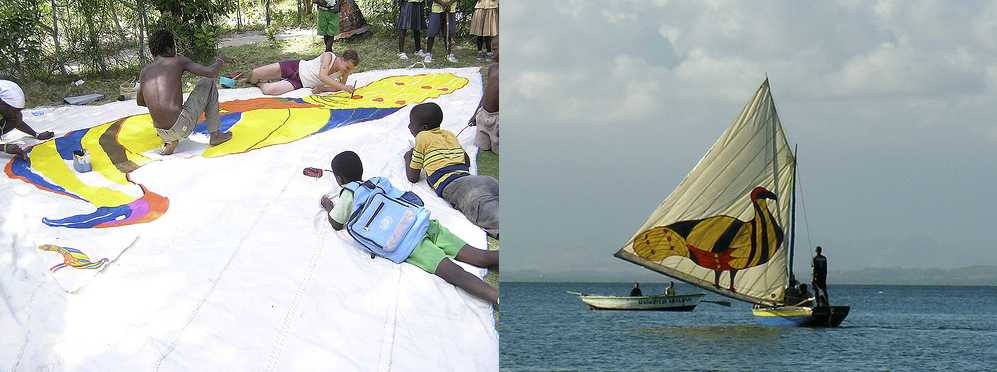
These pictures were taken over a week and a half by FOSAJ artists, staff and friends who visited le A Vache (an Island off Haiti's southern Coast) to paint on a sail designed for the "Sipriz," a small sailboat headed to Miami via the same route as typical "Haitian Boat People" expeditions, but in this case the Haitians aboard (two sailors and the boat builder) have legal visitor visas. The project is the brain child of Dutch writer Geert Vanderkolk, to whom we from FOSAJ are very grateful for the chance to participate and the chance to visit the enchanting Haitian Paradise known as Ile a Vache. The Boat and sail will be Exhibited at the Palm Beach Maritime Museum, and the Katzen Art Center at American University along with Paintings by FOSAJ artists.
GK: What’s mostly on your mind? What’s the next project, goal, trip and dream?
FM: I am really looking forward to doing my piece in the “Ghetto Biennale,” it will be the first time I will be making work and exhibiting in a “mixed” art scene, international artists with Haitian artists. Finally, we can all just be artists together in one place. Again the foreigners must come to Haiti if the there is supposed to be some semblance of us all working at the same level.
I am going to delve back into filmmaking for a bit. Inspired by our success following the premiere of “Maggots and Men” this past summer, I am anticipating the next project (and it might even help me with my identity crisis) Kathy Acker’s “Kathy Goes to Haiti.” Written in the early seventies, about a middle class white girl who goes to Haiti with no money, knowing no one, awkward conversations and promiscuity ensue. I will cast a transwoman as the lead along with a lot of other equally interesting people. To make it really interesting, I conceive that the film shoot itself will be a participatory performance art piece for all involved. The crew will be made up of friends mostly from the Bay Area, and collaborate with the Jacmel Film School.
I will be shooting the final chapter first (where Kathy goes to see a “Voodoo” priest and is actually a piece of journalism unlike the rest of the book which is one half pornographic, one half structural experiment) during the set up at the Ghetto Biennale. Uncut footage, and behind the scenes action will be screened at the Ghetto Biennale as a small video installation on the empty set. I love being on a film set anyway, but I think it will be really exciting to do this while all these other artists are making installations and performances in this particular place, which is the home base of the Atis Resistanz art collective, which itself is sandwiched between a junkyard and a cemetery in very hectic downtown Port Au Prince. It’s going to be so wild. I am wriggling in anticipation! If I am successful finding the funding, I will finish shooting the rest of the film as just a film at a later date.
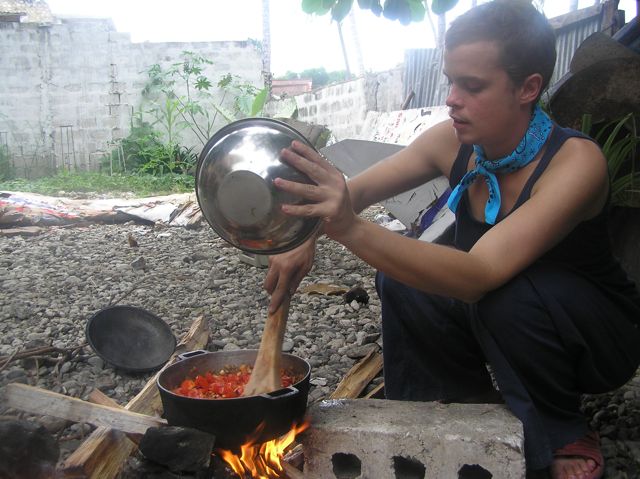
Flo McGarrell cooking, Jacmel, Haiti, 2009.
Also, I want to make agrisculpture beehives, and bee suits. Then start a family.
And that’s a wrap!




Pingback: What’s Cookin at the Art21 Blog: A Weekly Index | Art21 Blog
Pingback: RIP, flo mcgarrell « Posthaiti’s Blog
Pingback: Flo McGarrell «
Pingback: Land Art Generator Initiative
Pingback: MICA Graduate Leading Permaculture Workshop In Haiti Dies In Earthquake « Baltidome Blog: Baltimore Green News
Pingback: Remembering artist and friend Flo McGarrell | Art21 Blog
Pingback: Inflatable Artists… whoops, Inflatable Art « Jenesis Studios
Pingback: Flo McGarrell and Living to the Fullest | Caleb Cole
Pingback: Homage to Flo McGarrell | Julie Dermansky
Pingback: Thoughts of Flo McGarrell a Year After the Earthquake in Haiti | Julie Dermansky